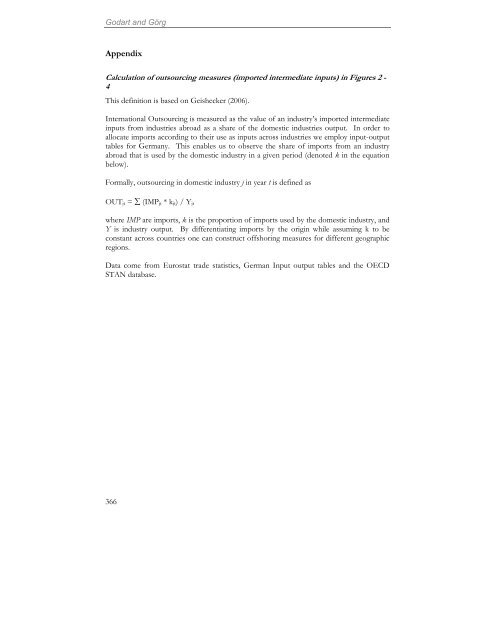The Role of Global Value Chains for German Manufacturing
The Role of Global Value Chains for German Manufacturing The Role of Global Value Chains for German Manufacturing
Godart and Görg Appendix Calculation of outsourcing measures (imported intermediate inputs) in Figures 2 - 4 This definition is based on Geishecker (2006). International Outsourcing is measured as the value of an industry’s imported intermediate inputs from industries abroad as a share of the domestic industries output. In order to allocate imports according to their use as inputs across industries we employ input-output tables for Germany. This enables us to observe the share of imports from an industry abroad that is used by the domestic industry in a given period (denoted k in the equation below). Formally, outsourcing in domestic industry j in year t is defined as OUTjt = ∑ (IMPjt * kjt) / Yjt where IMP are imports, k is the proportion of imports used by the domestic industry, and Y is industry output. By differentiating imports by the origin while assuming k to be constant across countries one can construct offshoring measures for different geographic regions. Data come from Eurostat trade statistics, German Input output tables and the OECD STAN database. 366
- Page 1 and 2: The Role of Global Value Chains for
- Page 3 and 4: The Role of Global Value Chains for
- Page 5 and 6: The Role of Global Value Chains for
- Page 7 and 8: Figure 1: German exposure to compet
- Page 9 and 10: Figures 3 and 4 break down services
- Page 11 and 12: The Role of Global Value Chains for
- Page 13 and 14: Table 6: Firms relocating abroad Th
- Page 15 and 16: The Role of Global Value Chains for
- Page 17 and 18: The Role of Global Value Chains for
- Page 19 and 20: The Role of Global Value Chains for
- Page 21 and 22: The Role of Global Value Chains for
- Page 23 and 24: The Role of Global Value Chains for
- Page 25 and 26: The Role of Global Value Chains for
- Page 27 and 28: The Role of Global Value Chains for
- Page 29 and 30: References The Role of Global Value
- Page 31: The Role of Global Value Chains for
Godart and Görg<br />
Appendix<br />
Calculation <strong>of</strong> outsourcing measures (imported intermediate inputs) in Figures 2 -<br />
4<br />
This definition is based on Geishecker (2006).<br />
International Outsourcing is measured as the value <strong>of</strong> an industry’s imported intermediate<br />
inputs from industries abroad as a share <strong>of</strong> the domestic industries output. In order to<br />
allocate imports according to their use as inputs across industries we employ input-output<br />
tables <strong>for</strong> <strong>German</strong>y. This enables us to observe the share <strong>of</strong> imports from an industry<br />
abroad that is used by the domestic industry in a given period (denoted k in the equation<br />
below).<br />
Formally, outsourcing in domestic industry j in year t is defined as<br />
OUTjt = ∑ (IMPjt * kjt) / Yjt<br />
where IMP are imports, k is the proportion <strong>of</strong> imports used by the domestic industry, and<br />
Y is industry output. By differentiating imports by the origin while assuming k to be<br />
constant across countries one can construct <strong>of</strong>fshoring measures <strong>for</strong> different geographic<br />
regions.<br />
Data come from Eurostat trade statistics, <strong>German</strong> Input output tables and the OECD<br />
STAN database.<br />
366



